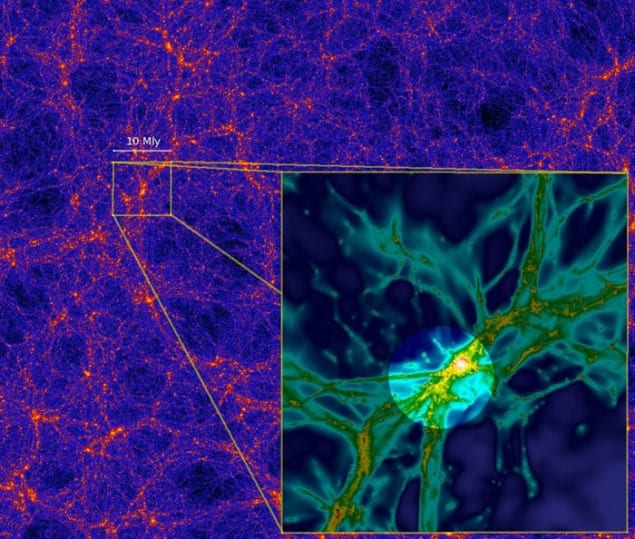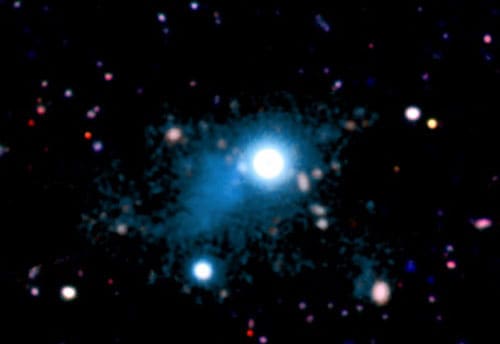
The first view of part of a filament of the “cosmic web” might have been glimpsed by astronomers, thanks to a quasar acting like a torch to illuminate the gas. The observations, made by an international team of researchers, could be the first evidence of the long-predicted large-scale structure of matter in our universe – a network of filaments thought to connect all matter, including galaxies and gas clouds. The team claims that its observations are challenging current theories and models of large-scale structures and can be used to further test and refine our understanding of how the universe evolved.
Cosmic labyrinth
Matter in the universe is not uniformly distributed. Instead, it exists in filamentary structures with intervening voids. The web is thought to have formed about 380,000 years after the Big Bang, when the universe was still young and the cosmic microwave background (CMB) – the thermal remnant of the Big Bang – came into being. While the growth and appearance of the web depends on the cosmological model used, its presence is a widely accepted theoretical prediction that has been backed up by various calculations and simulations, such as the Millennium Simulation.
The most recent CMB data from the Planck mission reveal a universe that is composed of 26.8% dark matter and 68.3% dark energy, while less than 5% is made up of “normal” visible matter, such as galaxies and gas clouds. This normal matter and dark matter is thought to co-exist in the cosmic web, as scientists believe that it is the dark matter that dictates where the galaxies and gas clouds form. In other words, the gas “feels” the gravity force of the dark matter and therefore traces it out across the cosmos. But only a tiny fraction of this gas is dense enough to produce the stars and galaxies that seem to form at points where filaments of the web intersect. Most of the gas, however, is too diffuse to produce stars and or emit its own light, thus making it difficult to observe. With the exception of some rare galaxy clusters, the cosmic-web gas is “cold” (at a temperature of 104 K) and so has never been directly detected. While the intergalactic gas is normally discerned by its absorption of light from bright background sources, the sparseness of a bright enough source means that the 3D structure of the web and how the gas is distributed is not revealed.
In order to get round this problem, Sebastiano Cantalupo of the University of California, Santa Cruz (UCSC) in the US, along with colleagues in the US and Germany, began looking for cosmic gas that is lit by one of the brightest sources in the universe – a quasar. Quasars are hugely energetic and luminous active galactic nuclei that are found in the furthest reaches of the observable universe. When lit by the ultraviolet (UV) light emitted by a quasar, the cosmic gas emits radiation at a particular wavelength of hydrogen (Lyman-α) in a process that is similar to fluorescence.
Nebulous torch
Cantalupo told physicsworld.com that the team built a narrow-band filter to study this Lyman-α radiation. “Originally, in the UV, the emission wavelength is stretched by the expansion of the universe and as it travels across 10 billion light-years, which is the distance to the quasar that we selected, it is shifted into the optical and therefore it is detectable with our optical telescopes,” he says. This new technique is referred to as “quasar fluorescent illumination”. Using the 10 m Keck I Telescope at the W M Keck Observatory in Hawaii, the team detected the presence of a long filament of gas or a nebula. It has a projected length of approximately 460 kiloparsecs (1,500,520 light-years) and was illuminated by the distant, radio-quiet quasar UM 287. The researchers conclude that it is part of the cosmic web, and Cantalupo and colleagues have dubbed their nebula the “Slug Nebula” in honour of the UCSC mascot – the banana slug.

Cantalupo further explains that the amount of radiation emitted by the filament depends on how much hydrogen is illuminated, as well as its density and distribution. This allows the team to infer the mass and physical properties of a cosmic web filament – an otherwise extremely difficult thing to do without having a direct image. When compared with predictions from simulations, the researchers found very good agreement when it came to the morphology of the filament. “This is the first time that such a large intergalactic filament has been detected. It extends well beyond the galactic environment of the quasar and therefore it is a confirmation of the existence of such structures predicted by models,” says Cantalupo.
Large-scale discrepancies?
The team’s observation does, however, present a challenge to our previous understanding of the web. “The filament appears too bright given the typical density and distribution of hydrogen gas in the simulated cosmic web,” says Cantalupo. One possible explanation of the discrepancy, he explains, is that the gas in the web is actually much denser and has a much more “clumpy distribution” than is predicted by current models. “This is telling us that we are likely missing some physical mechanism on intergalactic scales in our models. Our observation therefore is a unique (so far) laboratory to increase our physical knowledge on how matter is distributed in the universe,” he says.
In terms of the larger implications of this observation, the researchers say that they are still at the very early stages of their work but that the current study is a proof of concept that the new quasar-fluorescent-illumination technique works. “We need more than one filament for a proper statistical study and to draw implications on dark matter, dark energy and the large-scale structure of the universe,” says Cantalupo. “We are observing other quasars and we have other preliminary detections but ‘illuminated’ filaments appear to be rare. This is probably because of the fact that the opening angle of the ‘quasar light beam’ is small, as confirmed by other indirect studies of quasar emission, and therefore we need to observe a large sample of quasars to get more results.”
Cosmic muse
Currently, the team is increasing its sample of quasars using different filters on both the Keck and Gemini telescopes. Also, a new instrument – MUSE – has been delivered to the Very Large Telescope, ESO, in Chile, which can deliver several times more sensitivity than the narrow-band imaging the team is using now and will allow the researchers to detect more diffuse and larger structures around quasars. MUSE is also ideally suited to allow the researchers to look into an even earlier phase of the history of the universe.
The research is published in Nature.



